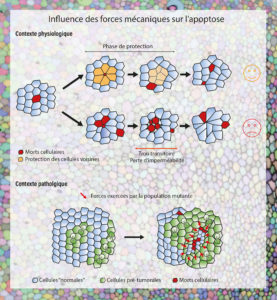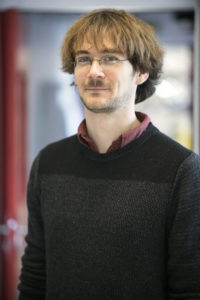Award
La SBCF est très heureuse de remettre son prix annuel Jeune Chercheur/Chercheuse SBCF doté de 5 000€ à Léo Valon, chercheur dans l’équipe de Romain Levayer à l’Institut Pasteur, Paris.
Léo Valon est un physicien, formé à l’Ecole Normale Supérieure ENS/ULM qui, après un master de Biophysique, a effectué une thèse co-supervisée par feu Maxime Dahan et par Mathieu Coppey à l’Institut Curie, où il a établi un système basé sur l’optogénétique afin de contrôler l’organisation cellulaire. Après cette expérience, Léo Valon a effectué son premier stage post-doctoral chez Xavier Trépat à l’IBEC de Barcelone où il a étudié de manière dynamique le lien entre contractilité cellulaire et translocation nucléaire du facteur de transcription YAP dans des modèles in vitro. Pour son deuxième post-doc, Léo souhaitait appliquer son expertise en mécanique à de la biologie cellulaire quantitative in vivo. Il rejoint ainsi l’unité «Mort Cellulaire et homéostasie des épithéliums» dirigée par Romain Levayer à l’Institut Pasteur. Cette équipe utilise le modèle drosophile afin de comprendre comment la mort cellulaire influence la plasticité tissulaire. Là il a découvert que lorsqu’une cellule de l’épithélium meurt, elle tire sur les cellules voisines ce qui active une voie de régulation pro-survie et les empêche de mourir, protégeant ainsi le tissu en lui conservant son imperméabilité. Il étudie actuellement le rôle de la compression des cellules comme facteur capable d’augmenter leur probabilité de mourir, processus pouvant jouer un rôle important dans le développement de certaines tumeurs.
Léo Valon is a physicist, trained at the Ecole Normale Supérieure ENS/ULM who, after a master’s degree in Biophysics, performed a thesis co-supervised by the late Maxime Dahan and Mathieu Coppey at the Institut Curie, where he established a system based on optogenetics to control cell organization. After this experience, Léo Valon did his first post-doctoral training with Xavier Trépat at IBEC in Barcelona where he studied the link between cell contractility and nuclear translocation of the transcription factor YAP dynamically using in vitro models. For his second post-doc, Léo wanted to apply his expertise in mechanics to quantitative cell biology in vivo. He thus joined the “Cell death and epithelial homeostasis” unit led by Romain Levayer at the Institut Pasteur. This team uses the Drosophila model system to understand how cell death influences tissue plasticity. There he discovered that when a cell of the epithelium dies, it pulls on the neighboring cells which activates a pro-survival regulatory pathway and prevents them from dying, thus protecting the tissue by keeping it impermeable. He is currently studying the role of cell compression as a factor that increases the probability of cell death, a process that may play an important role in the development of certain tumors.


